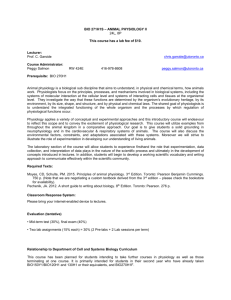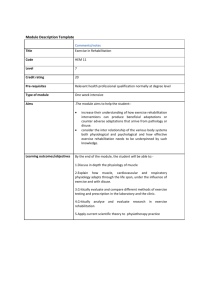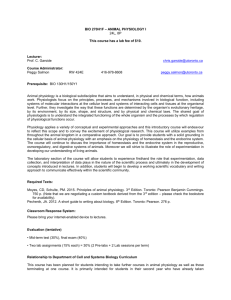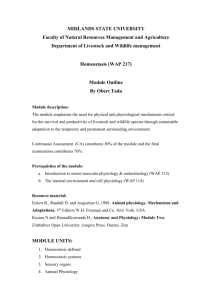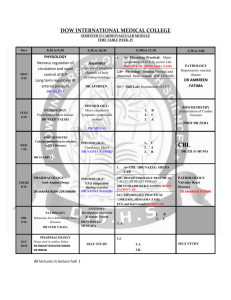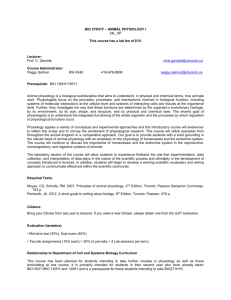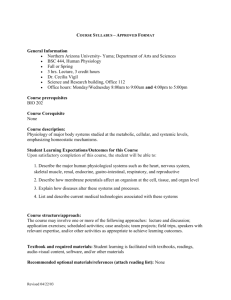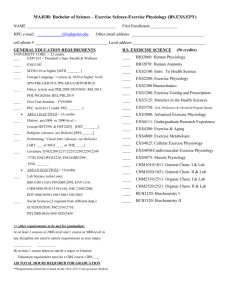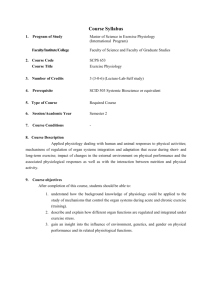EXERCISE PHYSIOLOGY DEFINITION, SCOPE AND IMPORTANCE
advertisement
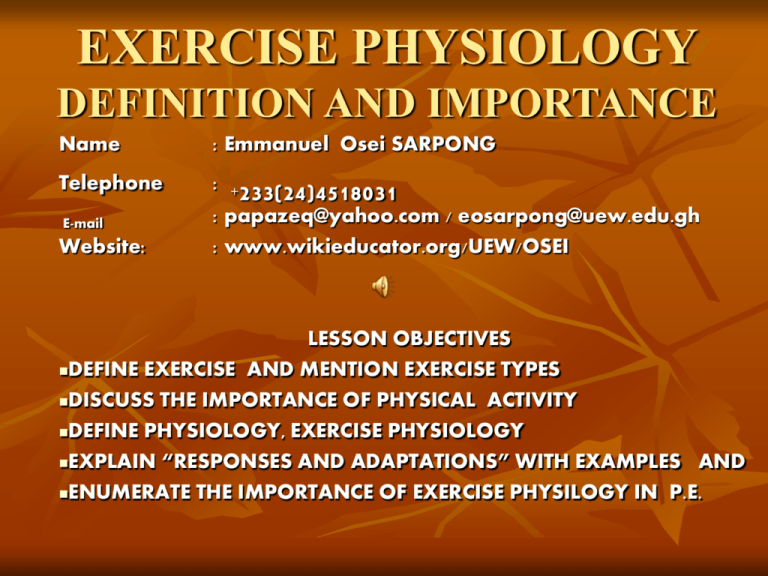
EXERCISE PHYSIOLOGY DEFINITION AND IMPORTANCE Name : Emmanuel Osei SARPONG Telephone : E-mail Website: + 233(24)4518031 : papazeq@yahoo.com / eosarpong@uew.edu.gh : www.wikieducator.org/UEW/OSEI LESSON OBJECTIVES DEFINE EXERCISE AND MENTION EXERCISE TYPES DISCUSS THE IMPORTANCE OF PHYSICAL ACTIVITY DEFINE PHYSIOLOGY, EXERCISE PHYSIOLOGY EXPLAIN “RESPONSES AND ADAPTATIONS” WITH EXAMPLES AND ENUMERATE THE IMPORTANCE OF EXERCISE PHYSILOGY IN P.E. introduction 1. 2. 3. Exercise physiology as an academic discipline consists of three distinct components namely: body of knowledge: built on facts and theories derived from research Formal course of study in institutions of higher learning Professional preparation of practitioners and future investigators and leaders in the field introduction The current academic discipline of exercise physiology emerged from the influences of several traditional fields primarily: anatomy, physiology and medicine. Each has a unique contribution to the understanding of human structure and function in health and disease Human physiology integrates with chemistry, biology, nutrition and physics to explain biological events and their sites of occurrence EXERCISE- WHAT IS IT? Means different things to different people Generally seen as the act of performing physical activity, putting stress to bear on the body, exposing the body to a stimulus Exercise is the performance of movements in order to develop or maintain physical fitness and overall health and it is often directed to the honing of athletic ability or skill EXERCISE TYPES Generally grouped into three types depending on the overall effect they have on the human body. These are: Flexibility: such as stretching improves the range of motion of muscles and joints Aerobic: such as running are rhythmic in nature, uses large muscle groups and can be maintained continuously. Here the working muscles draw on oxygen in the blood as well as fat and glucose to increase cardiovascular endurance(causes the heart to work harder than at rest) and muscle density. EXERCISE TYPES II Anaerobic: such as weight training or sprinting increase muscle mass and strength involves intense or explosive sports or strenuous activity that leaves one gasping for breath. It can be done for a minute or two at a time, because it depends on limited supply of glycogen that is rapidly depleted, resulting intense muscle fatigue. IMPORTANCE OF PHYSICAL ACTIVITY Frequent and regular physical exercise is an important component in the prevention of some diseases of affluence such as cancer, cardiovascular disease, type 2 diabetes, obesity and back pain Maintenance of physical fitness including healthy weight Building and maintenance of healthy bones, muscles and joints Promotion of psychological well-being Reduction in surgical risks PHYSIOLOGY It is the study of the functions of the body as a whole and of the structures and organs found there in. “physis” means nature or origin “logos” means speech or to talk about nature Physiology is the study of the mechanical, physical and biochemical functions of living organisms The under-listed are the divisions of physiology - Endocrinology: of hormones - Pathophysiology: mechanisms of disease - Neurophysiology :nervous system and - comparative physiology EXERCISE PHYSIOLOGY It is what happens to the body as it exercises a single time, and how these changes in function are brought about, what functional changes occur after repeated bouts of exercise how these changes come to pass, and finally what can be done to improve the body’s response to exercise and its adaptations to EXERCISE PHYSIOLOGY -II It is the DESCRIPTION and EXPLANATION of functional changes brought on by single (acute) or repeated (chronic) bouts of exercise, often with the objective of improving the exercise response. DESCRIPTION of functional changes deals with what happens to the body EXPLANATION also deals with the understanding of how these changes occur e.g. using the knowledge of the function of the skeletal system in the development of training programme(s). EXERCISE PHYSIOLOGY- III identification of physiological mechanisms underlying physical activity, the comprehensive delivery of treatment services concerned with the analysis, improvement, and maintenance of health and fitness, rehabilitation of heart disease and other chronic diseases and/or disabilities, and the professional guidance and counsel of athletes and others interested in athletics, sports training and human adaptability to RESPONSES AND ADAPTATIONS Exercise results in responses and adaptations depending on FREQUENCY, INTENSITY, TIME and TYPE A single bout of exercise is called ACUTE EXERCISE, whereas repeated bouts of exercise over several days or months may be called CHRONIC EXERCISE/TRAINING. Training is the systematic process with the objective of improving an athlete’s fitness in a selected activity. It is long term, progressive and recognizes the individual athlete’s needs and capabilities RESPONSES These are the sudden, temporary changes in function caused by exercise. These functional changes disappear shortly after the exercise period is over. Examples are: Increase in heart rate Rise in blood pressure, Increase in breathing ADAPTATIONS These are the persistent, permanent changes in structure or function following training that enables the body to withstand repeated bouts of exercise. These changes are long-term and may be seen after several weeks of training. Reduction of heart rate for sub-maximal exercise load. This allows the heart to pump the same amount of blood to the working muscles at a lower energy cost for the heart. Increased muscle size after strenuous weight lifting programme. The lifter exerts greater muscular force than before training. IMPORTANCE To answer the questions of the WHY, WHAT and the HOW of things in the body. To improve athletic performance To select appropriate exercises for different age cohorts, To explain exercise types for different sex groups To enhance overall health, and physical fitness of the general population What exercise physiologists do Researchers in universities and colleges Health, fitness and rehabilitation centers Educators Personal trainers, managers and entrepreneurs in the health industries Massage therapists, physical therapists, occupational therapists, nurses, nutritionists and physicians


